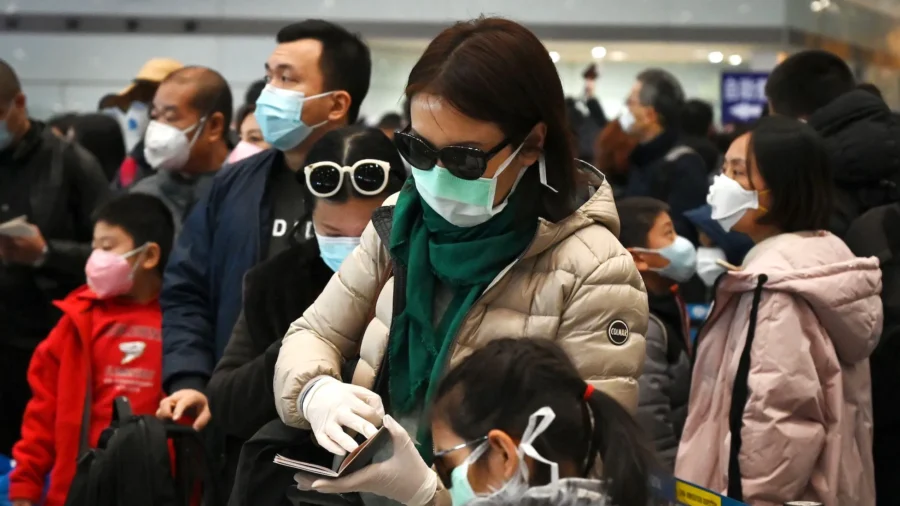China’s ruling communist party, the CCP, has suddenly announced it is discounting entry visa fees for travelers from more than a dozen countries amid a worsening mysterious pneumonia outbreak across the country.
The CCP’s Ministry of Foreign Affairs announced the 25 percent fee cut during a press briefing on Dec. 8, stating that after downgrading COVID-19 to a second-level infectious disease accompanied by less stringent preventative measures in Jan. 8, the regime has continued to improve visa policies in order to encourage more travelers to visit China.
The discount comes into effect at Chinese embassies and consulates on Dec. 11 and extends to Dec. 31 next year.
Following the announcement, Chinese embassies in at least 14 countries said they will reduce visa fees for the citizens in those countries to visit China. The countries include Azerbaijan, Bahrain, Cambodia, Fiji, Japan, Kazakhstan, Kyrgyzstan, Mexico, the Philippines, South Korea, Thailand, and Vietnam.
Earlier, on Nov. 24, the regime’s Ministry of Foreign Affairs announced that it would offer visa-free entry to six European and Asian countries: France, Germany, Italy, the Netherlands, Spain, and Malaysia starting from Dec. 1.
In two weeks, the CCP has relaxed entry visa policies targeting hundreds of millions of people in at least 20 countries.
Meanwhile, the mysterious pneumonia outbreak in China that is mainly affecting children, causing severe respiratory symptoms like “white lung” that was often see in serious COVID-19 cases continues to worsen across the country, and has spread to adults.
South Korea, the United States, the Netherlands, Denmark, and France have also reported a spike in pneumonia cases in recent weeks, while some nations like Japan and Taiwan are putting pressure on China and demanding more information from China on their outbreak.
Some leaders within national governments are worried that this wave of pneumonia might be like the initial stages of the COVID-19 pandemic that started three years ago, and have considered taking prevention measures to either require lung infection screening test for travelers from China or to put in place travel controls on China.
Taiwan’s health ministry on Nov. 30 urged the elderly, very young, and those with poor immunity to avoid traveling to China due to the outbreak.
Beijing responded to the World Health Organization’s request for data on the pneumonia outbreak that has lasted for three months by saying that no “unusual or new pathogens” have been found on Nov. 23.
However, the international community is not convinced, continuing to call the current child pneumonia outbreak in China “unknown,” “undiagnosed,” and “mysterious.”
WHO epidemiologist Dr. Maria Van Kerkhove said on Nov. 29, the WHO will “follow up with China” about the ongoing wave of respiratory infections.
Another Wave of COVID-19
The CCP has blamed different pathogens for the pneumonia outbreak in China that has again lead to white lung syndrome, naming in official statements multiple respiratory infections like mycoplasma pneumonia, influenza, and respiratory syncytial virus infection that it blamed for cross-infections, while largely avoiding “COVID-19” or “SARS-CoV-2.”
Sean Lin, an assistant professor in the Biomedical Science Department at Feitian College, former U.S. Army microbiologist, and Epoch Times contributor, told The Epoch Times that the question that the CCP needs to explain clearly now is: “Why do so many people now need to go to the hospital for treatment, severe cases require IV (intravenous) treatment, and even white lung [has appeared] and require lung washing, etc. How do you explain [the occurrence of these] severe cases?”
“Even if there is cross-infection, there is no specific explanation as to which two viruses are causing cross infections that make the symptoms worse.”
Dr. Gareth Nye, a programme leader for BMedSci Medical Science at Chester Medical School told British media that the mysterious wave of pneumonia spreading in China is another form of COVID-19, and not a new virus.
Shanghai resident Zhang Hong (pseudonym) told The Epoch Times’s sister media outlet NTD on Dec. 7 that two relatives of his had just passed away after acquiring suspected COVID-19 infections. His family is now handling the funerals.
Mr. Zhang said: “My two relatives passed away very quickly from this respiratory infection. That’s what the hospital said, they had the same symptoms, coughing and fever.”
“If you go to the hospital here, you can see that the situation is very scary. They all have this kind of fever and cough. But now, they don’t admit that this is COVID-19.”
He said that everyone thinks the COVID-19 is coming back but nobody dare to say it publicly.
In July, Shi Zhengli, China’s top virologist who specializes in conducting research on bat coronaviruses at the Wuhan Institute of Virology wrote in her published research paper in the scientific journal Emerging Microbes Infections that another COVID-19 outbreak is “highly likely.”
The Wuhan Institute of Virology has been widely suspected of having accidentally leaked the virus that caused the first COVID-19 outbreak in Wuhan in December 2019 and led to the global pandemic.
COVID-19 was originally called “Wuhan pneumonia” by Chinese.
Huang Yun and Xu Jian contributed to this report.

